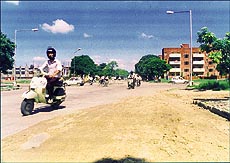Whether you are a
pedestrian or a vehicle-owner, roads in Chandigarh pose a
life-threatening risk. The silt on the road may upset the
balance of your vehicle and injure you, or you may hit a
pedestrian who has to walk on the road as footpaths have
disappeared. It is, therefore, not surprising that every
third person killed in a road accident in the city is
someone who uses his feet for locomotion, says Prabhjot Singh
 City roads: A hazardrous
journey City roads: A hazardrous
journey
CHANDIGARH is fast tuning into a
nightmare for pedestrians. Wide roads and huge
roundabouts notwithstanding, the city’s lack of
footpaths and walkways is responsible for a plethora of
problems for both the pedestrians and vehicle-owners.
For example, a school
teacher received multiple injuries when the two- wheeler
she was driving skidded on the silt-coated road near the
intersection of Sectors 20, 21, 33 and 34. This is not
the only intersection where silt poses serious problems
to drivers of two-wheeler. A large number of roads and
intersections in the city get covered with silt every
time it rains. The source of this silt is scrapped road
berms.
Hundreds of workers of
both the Municipal Corporation and the Engineering
Department of the Chandigarh Administration are deployed
the year round to clear the kerb channels of unwanted
growth. Besides, the scrapping of a few feet of berm on
either side of the road is also undertaken. This removal
of grass from the berms is directly responsible for the
growing problem of silting of roads and intersections.
Initially, the berms were
cleared to about four feet. Now it has come down to a
foot. And this one-foot area has streetlight poles. At
times, this space for pedestrians also remains dug up for
telephone cable repair work. Along the Madhya Marg,
wherever the Administration has provided slip roads, the
mandatory four feet distance from the built up area, too,
has been given a go by. At a couple of places, the slip
roads just scrape past built - up areas thus exposing
road- users to great risks.
Besides, the silt is
choking stormwater gulleys and hindering the quick
disposal of storm water into the underground system.
Two decades ago, almost
the entire city had concrete footpaths and walkways. At
that time prefabricated tiles were used for footpaths and
walkways. Gradually, these tiles started finding their
way into the houses of influential government employees
for the paving of backyards and courtyards, besides car
park areas.
The paving of footpaths
and walkways has been discontinued because some engineers
says that architects and town planners do not approve of
paved footpaths and walkways. Others hold the shortage of
funds responsible for it.
One of the major fallouts
of this has been the multifold increase in road accidents
from unauthorised road punctures, including those near
busy roundabouts. For example, traffic to Sector 20-D
generally enters the sector by traversing the pedestrian
area. Similarly, a number of two-wheeler owners on Sector
20-A jump onto the road dividing Sectors 20 and 21 from
unauthorised road punctures. Their movement is
facilitated by the absence of paved footpaths and
walkways. The situation is no different in other parts of
the city.
A number of town planners,
retired architects and engineers feel that no town can
afford to do without footpaths and walkways. Everywhere,
including fund-starved municipalities in Punjab and
Haryana, civic authorities have been concentrating on
providing paved footpaths not only to facilitate the
movement of pedestrians but also to check unauthorised
use of roads and berms by encroachers.
Informed sources claim
that the Department of Architecture is now considering a
proposal to provide paved footpaths in one of the sectors
on an experimental basis. Once public acceptability has
been ascertained, the experiment would be extended to
other sectors also, they say.
Another problem has been
of shopping areas where the Administration has provided
huge plazas. But in the absence of any maintenance and
upkeep, these plazas, including the one in Sector 17
shopping centre, have become encroachers’ paradise.
In other parts of the Sector, say 17-A and 17-B, the
plazas are in a shambles. The same is the case with the
rest of the Sector. At most places, tiles have been
removed, stairs are broken and huge piles of debris,
building material and garbage have accumulated.
When contacted, the Chief
Engineer, R. K. Jain, said that the practice of paving
footpaths with precast tiles is continuing. In fact,
estimates are being prepared to fill the gaps, if any,
with these tiles.
In some areas, new precast
tiles with Municipal Corporation markings have also been
used. But these are only in select shopping areas.
The situation is worse in
southern areas. Some of those who bought booths or
shop-cum-office sites and constructed their buildings,
are facing a series of problems. There are no access
roads, no parking areas and even the supply of
electricity to them is through temporary wooden poles.
.
|

